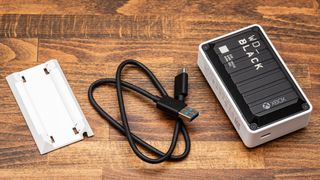Tom’s Hardware is supported by its audience. When you purchase through links on our site, we may earn an affiliate commission. Learn more
By published
The D30 is a portable gaming SSD designed for consoles, and that’s the niche it fits. It has otherwise mediocre to poor performance. The utilitarian design is competent but won’t win any awards.
Practical design, if physically larger than required
Works on PlayStation, Xbox, and PC, with designated console models
Slow write performance, particularly sequential and sustained
Mediocre all-around performance
The WD Black D30 is simply designed external storage for your games without any frills like RGB. It will work on modern consoles as well as PC, whether macOS or Windows, but is aimed at older titles for use on the PlayStation 5 and Xbox Series X|S. The variant we are testing today is for the Xbox and comes with a Game Pass Ultimate code to get your gaming journey started.
This drive is recommended for last-generation titles, because the current consoles have high-bandwidth NVMe drives and their recommended expansion options are also quite fast. 10 Gbps USB won’t cut it for that. On PC, DirectStorage is still in its infancy, but that API is designed for NVMe anyway. That being said, 10 Gbps is sufficient bandwidth for normal game loading, and the D30’s 2TB option is particularly compelling to hold a game collection.
WD’s original SN550 and its SanDisk counterpart made for a solid portable drive when paired with an enclosure. WD thought so, too, as they made models with this hardware and the ASM2362 bridge chip. While these drives are DRAM-less and HMB does not pass over USB, the overall design was such that sustained performance remained quite good. We will have to test the D30 to see if it holds up to that. Many manufacturers have been “nerfing” drives lately, including the SN550, so we’ll see what separates the D30 from its peers.
The WD Black D30 is available at 500GB, 1TB, and 2TB capacities. The price per gigabyte goes from $0.16 to $0.09 as the capacity increases, making the 2TB the best value. Games are always getting larger, so that may be the best investment regardless. While internally the drive is in the typical M.2 2280 form factor, externally the drive is attached by USB via the USB-C port with an included Type-C to Type-A cable. Although somewhat bulky, the drive is a relatively lightweight 125 grams.
The drive is not rated in any special way but comes with a stand and is bus-powered. The casing does seem thick, so it should offer some protection. As the drive is limited by the USB 3.1 interface, that is 10 Gbps SuperSpeed+, it’s only rated for up to 900 MBps with regard to sequential reads and writes. The warranty is unexceptional at three years.











The bridge chip is the ASMedia ASM2362, a popular alternative to JMicron’s JMS583 and Realtek’s RTL9210B. This bridges x2 PCIe 3.0 to USB 3.1 at 10Gbps. Most 20 Gbps portable drives utilize its faster sibling, the ASM2364. ASMedia lists the ASM2362 as USB3.1 Gen2 (USB 3.1) which is SuperSpeed+ and is equivalent to USB3.2 Gen 2×1. This has more than twice the bandwidth of SuperSpeed 5 Gbps, or USB 3.0 (USB Gen 3.2 1×1) due to improved encoding.
Basically, the chip has two lanes of PCIe 3.0 on the drive side and a 10 Gbps interface on the USB side, for a performance peak around 900 MBps in this case. The JMS583 is popular in many “DIY” enclosures but had early firmware issues, while the Realtek RTL9210B is often considered the best of the bunch. The RTL9210B, though, does have the advantage of working with SATA drives.
MORE: Best SSDs
MORE: How We Test HDDs And SSDs
MORE: All SSD Content
Current page: Features and Specifications
Shane Downing is a Freelance Reviewer for Tom’s Hardware US, covering consumer storage hardware.
Get instant access to breaking news, in-depth reviews and helpful tips.
Thank you for signing up to Tom’s Hardware. You will receive a verification email shortly.
There was a problem. Please refresh the page and try again.
Tom’s Hardware is part of Future US Inc, an international media group and leading digital publisher. Visit our corporate site.
© Future US, Inc. Full 7th Floor, 130 West 42nd Street, New York, NY 10036.










